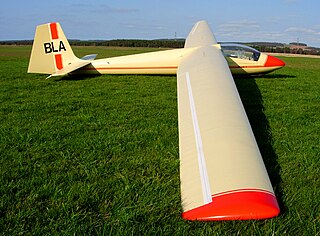Related Research Articles

The SZD-45 Ogar (Hound) is a T-tailed cantilever high-wing monoplane of wooden, aluminium and fibreglass construction designed and manufactured in Poland.

The Slingsby T.50 Skylark 4 was a British single seat competition glider built by Slingsby Sailplanes in the early 1960s. It sold in numbers and had success at national, though not world level competition.

The LAK-12 is a Lithuanian mid-wing, single-seat, FAI Open Class glider that was designed and produced by Lietuviškos Aviacinės Konstrukcijos (LAK) in Lithuania and later by Sportine Aviacija and Sport Aviation USSR.
The Akaflieg Darmstadt D-34 sailplanes were a series of experimental single seat sailplanes, designed at the University of Darmstadt in the 1950s and early 1960s to explore the structural and aerodynamic advantages of the then emerging plastics and composite materials.

The Bréguet Br 905 Fauvette is a single-seat, standard class, competition sailplane, designed and produced in France from the late 1950s. Some 50 were built but most remained grounded after a structural accident in 1969; a few remain airworthy.

The SZD-42 Jantar 2 is a single seat Open Class competition glider, designed and produced in Poland in the 1970s. It features a span of over 20 m (66 ft) and elastic, camber changing flaps. It was placed second, third and seventh at the 1976 World Gliding Championships. Over one hundred were built and more than ninety remain registered.
The Akaflieg Braunschweig SB-6 Nixope was an early (1961) GRP high performance single seat glider designed and built in Germany by aeronautical students from Brunswick University. It competed in the 1961 German National gliding competition, coming sixth, and led directly to two further GRP aircraft.
The Scheibe SF-30 Club-Spatz is a 15 m class single seat sailplane built in Germany in the 1970s and intended for club use.
The VFW-Fokker FK-3 is a single seat competition glider, built in Germany in the late 1960s. It had success at the Italian and Austrian national contests of 1968, resulting in a short production run the following year.
The LAK-16 is a single-seat, open-girder primary glider in the 1930s tradition but constructed with modern materials. It was produced in the 1980s in Lithuania.

The Orlican VT-16 Orlik is a single-seat club glider, serving Czech gliding clubs and setting several national records in the early 1960s.
The IIL IS-9 was a low powered, experimental pod and boom style motor glider, designed and built in Romania in the late 1950s.
The Schleicher K 10 is a Standard class competition glider, designed by Rudolf Kaiser and built in Germany in 1963. Only a few were produced.
The Civil Aviation Department BS-1 Bharani was a tandem seat trainer glider designed and built in India in the early 1960s.
The Civil Aviation Department Kartik was an Indian single seat competition glider first flown in 1963. It was built in small numbers and remained under development until 1975.
The Civil Aviation Department Ashvini was the first two-seat glider designed and built in India. It was produced in small numbers in the early 1960s.

The Rubik R-03 Szittya I was a Hungarian single-seat sailplane flown in the late 1930s. The design was developed through three improving variants. though only one of each was built.
The Oškinis BRO-23KR Garnys (Stork) is a glassfibre primary glider, built in the USSR in the early 1980s. Only two were completed.
The Oškinis BRO-11 was a primary glider designed in the USSR. It was produced in large numbers from the 1950s.
The LAK-15, sometimes known as the LAK-15 Lietuve, was a high performance sailplane designed to set records. A one-off, it was built in the late 1980s in Lithuania, then a member of the USSR.
References
- ↑ "LAK-14 Strazdas". j2mc Planeurs. Retrieved 4 September 2019.
- 1 2 Taylor, John W. R. (1984). Jane's All the World's Aircraft 1984-1985. London: Jane's Publishing Co. pp. 644–46. ISBN 0710608012.
- ↑ Taylor, John W. R. (1987). Jane's All the World's Aircraft 1987-1988. London: Jane's Information Group. pp. 767. ISBN 0710608500.